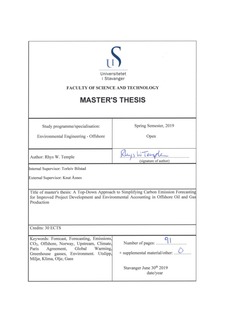| dc.contributor.advisor | Bilstad, Torleiv | |
| dc.contributor.advisor | Åsnes, Knut | |
| dc.contributor.author | Temple, Rhys W. | |
| dc.date.accessioned | 2019-10-22T11:24:49Z | |
| dc.date.available | 2019-10-22T11:24:49Z | |
| dc.date.issued | 2019-06-30 | |
| dc.identifier.uri | http://hdl.handle.net/11250/2623701 | |
| dc.description.abstract | A combination of factors including environmental, resource availability, investor weariness and public perception of the oil and gas industry challenge the competitiveness of the sector in Norway and around the world. One frequent topic of discussion addressed in these areas of concern, as well as an opportunity for improvement, is the generation of CO2 from upstream oil and gas production. Forecasting these emissions serves many purposes and may alleviate some of these challenges while benefiting the environment. Currently, emission forecasting in the industry may not meet current needs, are complex, and can be done more simplistically. This study has aimed to produce a novel and simplified means to estimate upstream oil and gas emissions. Through a data-driven statistical method, emission and production volume histories as well as drainage strategy at the asset level were analyzed to build two emission models. The methodology derived in this thesis is not currently used in upstream emissions calculations and is novel for the oil and gas industry. The results of the modeling demonstrate the models’ ability to approximate emissions using less data, resources and knowledge than were previously needed while also providing a level of accuracy desired for industry workflows including already established requirements for project and business development in Equinor. The benefits these models provide allow emission forecasting to be less hindered by data requirements, more able to meet today’s growing demands and accelerate decision-making abilities to meet future needs. Further, the methodology is flexible and applicable to numerous industrial process which signifies a green light for expanding the use of data and furthering digitalization efforts within the oil and gas industry and elsewhere. | nb_NO |
| dc.language.iso | eng | nb_NO |
| dc.publisher | University of Stavanger, Norway | nb_NO |
| dc.relation.ispartofseries | Masteroppgave/UIS-TN-IKBM/2019; | |
| dc.subject | CO2 | nb_NO |
| dc.subject | forecast | nb_NO |
| dc.subject | teknisk miljøvern | nb_NO |
| dc.subject | miljøteknologi | nb_NO |
| dc.subject | offshore teknologi | nb_NO |
| dc.subject | offshore technology | nb_NO |
| dc.subject | emissions | nb_NO |
| dc.subject | upstream | nb_NO |
| dc.subject | climate change | nb_NO |
| dc.subject | klimaendringer | nb_NO |
| dc.subject | climate risk | nb_NO |
| dc.subject | global warming | nb_NO |
| dc.subject | global oppvarming | nb_NO |
| dc.subject | greenhouse gas | nb_NO |
| dc.subject | environmental engineering | nb_NO |
| dc.subject | utslipp | nb_NO |
| dc.subject | miljø | nb_NO |
| dc.subject | klima | nb_NO |
| dc.subject | oil | nb_NO |
| dc.subject | gas | nb_NO |
| dc.title | A Top-Down Approach to Simplifying Carbon Emission Forecasting for Improved Project Development and Environmental Accounting in Offshore Oil and Gas Production | nb_NO |
| dc.type | Master thesis | nb_NO |
| dc.description.version | submittedVersion | nb_NO |
| dc.subject.nsi | VDP::Technology: 500::Environmental engineering: 610 | nb_NO |
